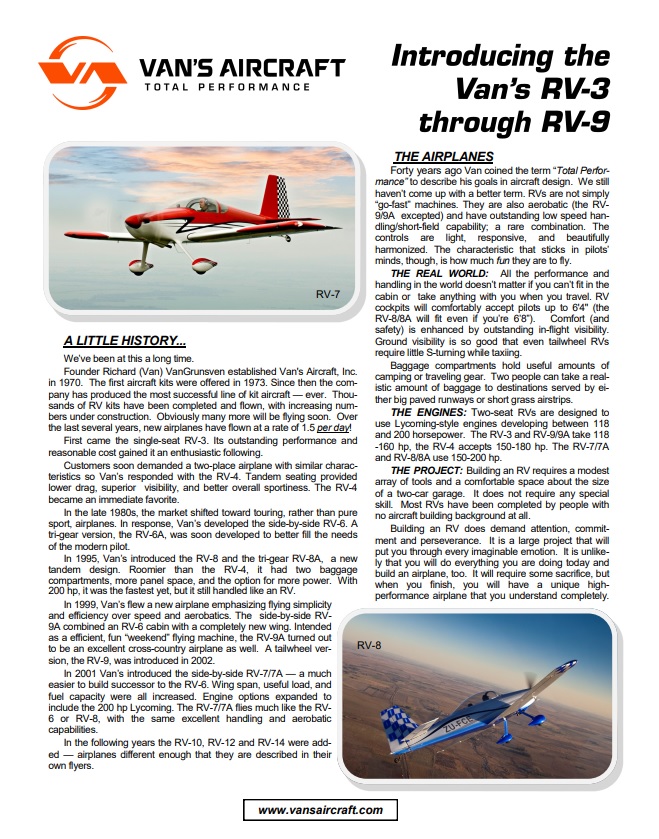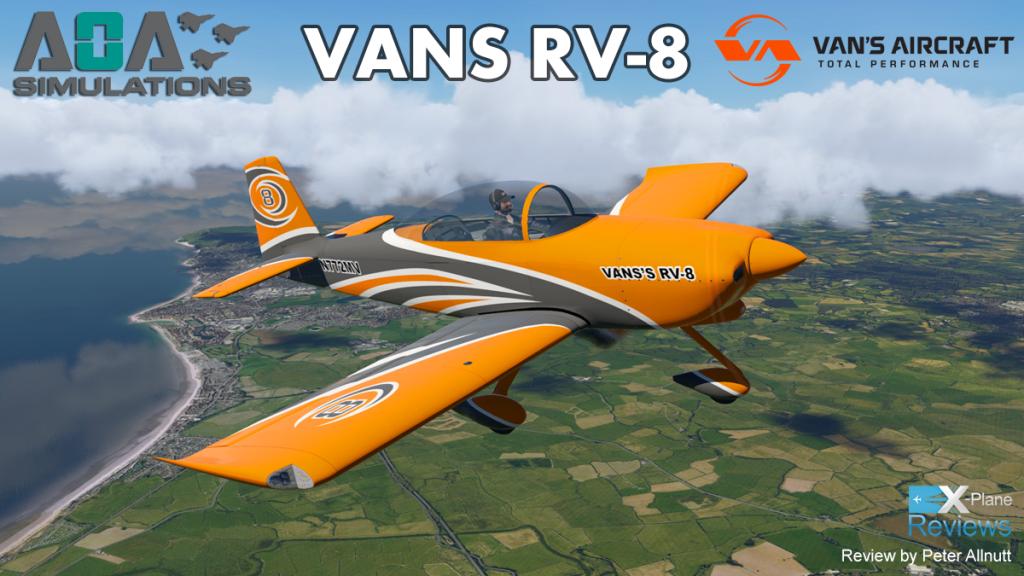Leaderboard
Popular Content
Showing content with the highest reputation on 02/01/23 in Posts
-

Aircraft Review: Van's RV-8 /8A Duo by AOA Simulations
FrMan reacted to Dominic Smith for a topic
Aircraft Review: Van's RV-8 /8A Duo by AOA Simulations By Peter Allnutt Founded in 1973 in the USA by Richard Van Grunsven, Van’s Aircraft has, for the last fifty years, produced a series of highly successful low-wing monoplane kit aircraft. One of those kits is the RV-8, a two-seat aerobatic model featuring a bubble canopy providing good all-around visibility. It first flew in 1995 and as of late 2022, over 1500 have been built. Like the RV-4, the RV-8 variant has two seats, one behind the other and is generally larger overall. The two-seat RVs are designed to use Lycoming-style engines developing between 118 and 200 horsepower, although a higher performance derivative was also produced, the Harmon Rocket. This had clipped wings and utilised a Lycoming IO-540 engine with 300 horsepower. There are two variants of the RV-8 kits available from the manufacturer, one with a traditional taildragger configuration and the RV-8A, which uses a tricycle undercarriage instead. Purchase & Installation Three different packages of the RV-8 are available to purchase via the X-Plane.org store: taildragger, tricycle or a package including both. The individual aircraft are priced at $24, with the Duo Pack (being reviewed here) costing $32. With your purchase completed, you are provided with a link in which to download the required 150MB ZIP file. When done, it’s just a simple case of extracting the file and then copying it over to your X-Plane “Aircraft” folder (no activation keys required). Included in the download, is a rather nice X-Plane user guide and a brochure from Van’s Aircraft, introducing you to their range of models. There is also a document for Apple users detailing the required security setting. The user guide is twenty pages in length and is well worth a read as it explains how to lean the engine and perform aerobatics, along with a suggested button guide for joysticks and other helpful tips. Note: At the time of writing the RV-8 package is for X-Plane 11 only, but the developer has stated that an X-Plane 12 version is in development (will be a free update to existing customers) and will be released when the new simulator is deemed ready. Exterior Model The RV-8 has a relatively simple shape, something I assume aids with its kit construction. It is well-modelled and judging by images I have seen of the real thing, is accurately proportioned. I didn’t spot any real visual differences in the engine cowlings, but the RV-8 is modelled with 180HP, whilst the RV8A gets the increased 200HP powerplant. As with most AOA models, there are some nice touches included, such as the “Remove Before Flight” ribbons if you start from cold and dark. AOA’s RV-8’s control surfaces are nicely animated, as is the cockpit canopy, which automatically closes when the aircraft reaches 10MPH and above (perfect for those who tend to forget such things). The wheel covers and rear suspension are also nicely modelled, as are the light clusters in the wingtips. There is also a little cubbyhole just in front of the cockpit which contains a first aid kit, a fire extinguisher, plus room for a few small personal items. There are a few liveries included with the model, as well as a paint kit should you wish to create your own. As well as those already supplied, AOA Simulations have also made available several livery packs for download, the link for which, can be found in the user guide. Additional liveries from the developer can also be found at the Org. Cockpit & Functionality Moving on to the interior of the RV-8 and I found that whilst good, the modelling wasn’t quite up to the same standard as the exterior, the footwell being one example, which looked slightly odd in my opinion. Also, the prop and mixture handles seemed a bit on the small side, but then again, perhaps I just have big hands! Texturing was, for the most part, very nicely done, although it did seem a bit too clean. Whilst I appreciate the fact that this is a kit aircraft, it would be nice to see a degree of weathering applied (not all aircraft will be new). Both variants in the package sport the same glass cockpit configuration, two G1000 displays, a Garmin 430 GPS, a Garmin 245A Audio Panel and a Garmin GFC500, so you’re not left wanting by any means. The engine start checklist is displayed on the Garmin 430’s display when the battery switch is set to on, and this updates as the steps are completed. When you’re ready to operate the starter, you get a nice audio call of “Clear Prop”, which I thought was a nice touch! AOA Simulations also provide a plug-in which enables you to toggle the “Extras” option on and off. When selected, you will find that it adds additional information to the two GF1000 displays. On either side of the pilot, there are two side pockets which can be activated. The one on the left brings up the default X-Plane map, whilst the one on the right brings up AviTab (if installed). AOA’s RV8/RV8-A also comes equipped with a rather neat smoke system (red and blue available) which is activated by switches on the right-side panel, along with oxygen controls. Handling In terms of handling, I think it’s important to point out, that I am not a real-world pilot and as such, I can’t really comment on the authenticity of the flight model. However, in saying that, I was extremely impressed by how the model performed in the air, and I can only put that down to AOA’s exceptional modelling talents and the fact that this X-Plane model was developed with the help of the Van’s Aircraft Company. This is an aircraft that can be calm and docile one minute, and then totally exhilarating the next…wonderful! Taxiing in the tail dragger variant of the RV-8 is slightly more challenging than the tricycle version (RV-8A) due to the slightly upward view and the tailwheel. When throttling forward during takeoff, it’s immediately noticeable that there is plenty of power at hand, and when airborne, the little RV-8 will climb at 2000fpm, which is quite impressive for such a small aircraft. During the cruise phase (around 170 KTS), both variants were easy to trim out, but if you’re feeling lazy, then there is the autopilot to help you out should you wish. As mentioned earlier, the RV-8 is reasonably aerobatic, and as such, I managed to perform quite a few aerobatic manoeuvres during my testing, all without too much difficulty. Okay, they weren’t particularly textbook, and I wouldn’t have won any awards, but it goes to show you what the aircraft is capable of. The controls are quite sensitive, so it’s fairly easy early on to overdo some of the inputs, but you know what they say… practice makes perfect! Landing either of the models was straightforward, with touchdown being at around 60-70 KTS. The RV-8 only has two stages of flaps, one for takeoff, and the other for landing. This means that during the approach phase, you’ll notice additional drag caused by the flaps, so you’ll have to adjust power and trim as required. AOA Simulations have also included an excellent “Brake With Stick” (BWS) feature via their plug-in. This is particularly useful for those simmers who don’t have rudder pedals with toe brakes (and there are many), as it means that upon touchdown, all that is required to activate the brakes is to push the stick forward…very imaginative and extremely useful. Sounds The RV-8’s included sounds are well-sampled and of good quality, with the engine sounding particularly nice. There was no audible looping present, and at no time did the soundset become monotonous or intrusive. The numerous “click” points in the cockpit were present, but I was disappointed I couldn’t hear the difference between a switch-on and a switch-off action and the canopy closing didn’t give a reassuring clunk when fully shut. However, I did notice that the engine was nicely muffled when the canopy was closed, so that was another nice touch. Performance During my testing of AOA’s RV-8, I experienced no performance issues whatsoever. Framerates remained high and there were no noticeable lags or spikes. For reference, my X-Plane setup is as follows: Intel i9 10900K – 32GB RAM - NVIDIA MSI RTX 3090 Suprim X – Windows 10 Home 64 Bit, so as you can see, quite a capable system. Conclusion Summing up, I have to say that AOA’s RV-8 is a wonderfully enjoyable and fun little plane to fly. Not only is it a capable tourer thanks to its good cruise performance, but it’s equally happy when performing the odd aerobatic manoeuvre. The modelling, both inside and out, is done well, and apart from a few issues with the sounds, I can’t really think of any reason why you shouldn’t add this little flyer to your hangar. Overall, the AOA RV-8, is a terrific addition to the GA family of aircraft available for X-Plane, and I hope the updated version for X-Plane 12 won’t be too long in the making. ________________________ The Van's RV-8 /8A Duo by AOA Simulations is now available from the X-Plane.Org Store here: Van's RV-8 /8A Duo Priced at US$32.00 Features Accurate flight model Detailed cockpit and exterior with animations, manipulators and PBR textures VR-Ready Custom particles emitters Customized Garmin G1000 PFD and MFD FMOD Sounds Ground equipment Animated pilot Dynamic pilot POV camera options (non VR mode) Automatic AI plane tracking pilot POV camera capability (non VR mode) Garmin GFC 500 Included in the package 5 HD liveries + more than 30 liveries available at www.x-plane.org Comprehensive User Guide Photoshop Paintkit Requirements X-Plane 11 - X-Plane 12 when available (in progress) Windows, Mac, or Linux 4GB VRAM Minimum - 8GB+ VRAM Recommended Current version: 1.5 (October 6th, 2022) Review System Specifications Intel i9 10900K – 32GB RAM - NVidia MSI RTX 3090 Suprim X – Windows 10 Home 64 Bit __________________________________ Aircraft Review by Peter Allnutt 31st January 2023 Copyright©2023: X-Plane Reviews (Disclaimer. All images and text in this review are the work and property of X-PlaneReviews, no sharing or copy of the content is allowed without consent from the author as per copyright conditions.1 point






















































